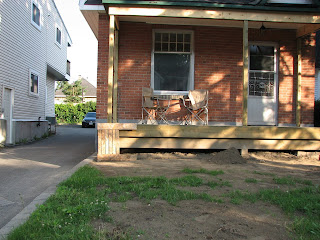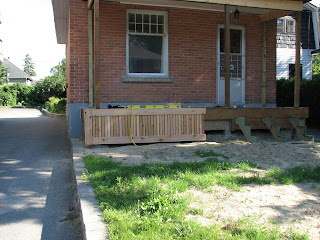A few changes I made to the plans:
- I upgraded the joists from 2x4's to 2x6's,
- Added a joist so they were on 16" centres. I just thought that made sense from a structural point of view.
- Adding a few strengthening stuff here and there.
- Added a concrete strip footing, some would say overkill, I'm just like that.
- I didn't like the top cap of the railing over top of the slide, so I added a post beside the slide and will stop of the railing halfway across.
- On the top frame which will hold the canopy, I added a 2x4 (for strength) beside the front/back 2x4d aligned with the wide axis down. I just figured if my little guy will swing, it might be from there
- I added a 4x4 beam which the swing beam will rest on. I bolted the swing beam to the vertical column, and used a post to beam connector to attach the swing arm to the beam I added. Note that I don't want the three swings, so I have some extra length for this. Otherwise, you would need a longer beam.
- I bolted through the two joists and 4x4 posts at the deck level.
1. -- Making the concrete forms
2. -- Digging out the dirt. I want the concrete footing at below grade so no heads will bump on it.
3. -- Concrete poured, gotta put a big letter H in the concrete for history to know about our efforts!. In the end, I mixed 8.1, 30 kg bags of concrete. The footing is around 5' - 3" wide, for a 1.5" overhand (play structure frame is 5' x 5'). The inside dimension was too small, so I made extra concrete for no reason. oh well.
4. -- ok, maybe this was overkill, but it was HOT. I kept an old sheet moistened for the first 24 hours to keep the concrete moist in the heat.
5. -- Finished footing
6. -- Starting the structure. Nothing too major here, posts, bolts, etc. The bolts are countersunk so they don't stick out for safety reasons.
7. -- Framing, fasteners, etc.
8. -- Started the railings.
9. -- Railing done expect where slide will go.
10. -- A view with the extra post I added. It's well blocked and bolted. Bolts for strength. Blocking for strength too, but also to give the decking support.
11. -- Final view for tonight. I ended up getting the cedar 5/4 deck boards installed, but no photo. Pizza was waiting and it was a long day.
12. -- Cedar 5/4 boards on! Notched nicely around the posts if I do say so myself.
13. -- A few seats for the sand box.
14. -- I bolted through the 4x4s and both joists at each corner, deck level. I didn't have a drill bit long enough to make the entire hole, so I made this little jig so I could drill easily through both sides, no measuring.
15.. -- Jig in action! Worked really well.
16. -- Final state for the weekend. The swings, slide, etc are all on order. If you look at the front top 2x4 and compare it to the original plans, you'll see the extra piece I added.
17. -- Sand box full of sand. I had 0.5 cubic yards delivered, and used maybe 0.4 yards.
18. -- Getting some action. Now we can't wait until the slide, swings and accessories arrive!
Have any online links or sources for other free play structure plans? Leave a comment, I'd love to check them out.




























































